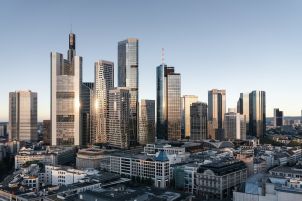On a European scale, the building sector represents
- 40%
of EU energy consumption for building use
- 36%
of EU greenhouse gas emissions for building use
Source : European Environment Agency (EEA)
The impacts of our issues
Identification of the economic impact of BNP Paribas Real Estate's challenges
|
Impacts économiques
|
Risques
|
Opportunités
|
Enjeux
|
|---|---|---|---|
|
ODD 8 (targets 8.2-8.4) |
Loss of customers by not anticipating new expectations Non-sustainability of the economic model Failure to respond to societal priorities Economic failures of clients and occupants |
Anticipating changes in the real estate sector Adapting to post-pandemic expectations |
Anticipating changes in the real estate industry |
|
ODD 9 (targets 9.1-9.2) |
Stopping or slowing down of activities Lack of or poor crisis management Lack of reactivity in case of crisis Lack of crisis communication |
Resilience Plan |
Risk prevention and business continuity |
|
ODD 9 (target 9.c) ODD 16 (targets 16.4-16.a) |
Insecurity and instability of information systems Cybercrime Information systems breakdown |
Stable connectivity |
Information networks and connectivity |
|
ODD 16 (targets 16.4-16.5) |
Lack of transparency Regulatory and market non-compliance Corruption, fraud, money laundering, anti-competitive behavior and non-compliance Lack of exemplary governance |
Corporate Social Responsibility Business ethics and professional conduct |
Ethics and transparency |
|
ODD 11 (targets 11.3-11.a-11.b) |
Loss of clients due to non-anticipation of new expectations Lack of retention of business partners Supply chain instability |
New occupant expectations Stability of the value chain |
Co-creation with our customers and business partners |
|
ODD 8 (Target 8.3) ODD 11 (Targets: 11.a-11.b) |
Lack of local economic involvement Uncontrolled urbanization Regional imbalances |
Sustainable economy Solidarity Support for essential services |
Positive local contribution |
Identification of the environmental impacts of BNP Paribas Real Estate's challenges
|
Impacts environnementaux |
Risques |
Opportunités |
Enjeux |
|
ODD 6 (targets 6.2-6.3-6.4-6.5) |
Global water crisis Groundwater pollution Water stress Conflicts over access to water Biodiversity damage |
Recycling and reuse of treated wastewater |
Sound water management |
|
ODD 7 (targets 7.2-7.3) |
Strengthening regulatory requirements for energy consumption Strengthening the law on energy transition |
Low carbon strategy Renewable energy Energy intensity and efficiency |
Energy efficiency and sobriety |
|
ODD 11 (target 11.2) |
Lack of safe, accessible and sustainable public transport Remoteness from urban centers |
Sustainable mobility |
Sustainable mobility |
|
ODD 11 (targets 11.5-11.6) |
Risks of pollution (air, light, noise and visual) and allergies for building occupants and residents |
Sustainable cities and communities |
Air quality and building comfort |
|
ODD 12 (targets 12.2-12.5) |
Resource scarcity Pollution from waste Poor product life cycle management Regulatory non-recyclability Building obsolescence |
Circular economy Flexibility and reversibility of buildings |
Resources and circular economy |
|
ODD 12 (target 12.2) |
Regulatory non-compliance Image and reputation in the markets Non satisfaction of customers and occupants with environmental certification |
HQE certification Environmental labeling |
High environmental performance and certification |
|
ODD 13 (target 13.1-13.3) |
Physical risks: low emission reductions and regulatory or market penalties Transitional risks: weak in reducing emissions |
Energy transition |
Adaptability and resilience to climate change |
|
ODD 13 (target 13.3) |
Physical risks: global warming and impacts on the functioning of buildings and services Instability and energy insecurity Regulatory non-compliance in carbon neutrality |
Low carbon strategy Carbon neutrality objective |
Low carbon products and services |
|
ODD 15 (target 15.3) |
Intensive land artificialisation Soil sealing Urban sprawl |
Sustainable cities |
Soil Artificialisation and Urban Sprawl |
|
ODD 15 (targets 15.5-15.8-15.9) |
Industrial accidents Soil pollution and erosion Accidents related to hazardous waste Destruction of natural ecosystems Concept of biophilia (living building) Biodiversity, biophilia and land use |
Concept de la biophilie (immeuble vivant) |
Biodiversité, biophilie et occupation des sols |
Identification of the environmental impacts of BNP Paribas Real Estate's challenges
|
Impacts environnementaux |
Risques |
Opportunités |
Enjeux |
|
ODD 3 (targets 3.4-3.9) ODD 8 (target 8.8) |
Occupational health and safety accidents Building accidents for occupants Customer health and safety accidents Pandemic control |
Wellness and quality of life Telecommuting and flexibility Building health safety Service digitalization |
Wellness, health and safety in buildings |
|
ODD 4 (targets 4.3-4.4) |
Lack of preparation of employees for changes in their jobs Talent drain Lack of employee commitment Decline in employability |
Digital transformation CSR training |
Adaptation of employee skills to tomorrow’s professions |
|
ODD 5 (targets 5.1-5.5) ODD 8 (target 8.5) ODD 10 (targets 10.3-10.5) |
Disengagement of women employees Social non-compliance Decline in performance Image and reputation |
Parity in governance |
Diversity and professional equality |
|
ODD 8 (targets 8.7-8.8) ODD 10 (target 10.2) ODD 16 (target 16.10) |
Human rights violations (forced labor, minors, migrants, personal data, living wage, non-excessive fees, etc.) |
Inclusion Inclusion |
Human rights and non-discrimination |
|
ODD 12 (targets 12.6-12.8) ODD 13 (target 13.3) |
Departure of employees due to lack of sense of purpose and commitment to CSR (weakened culture) Issues of reporting and appropriation of CSR |
CSR policy CSR training CSR reporting |
Integration of CSR in the business lines |




